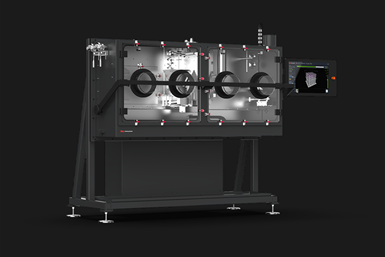Desktop Metal P-1 Promises SPJ Process Development Solution
Desktop Metal’s new P-1 printer provides a smaller-scale Single Pass Jetting printer that better facilitates prototyping than the full P-50.
Share






Desktop Metal has begun shipping its new P-1 printer. The P-1 leverages the same patent-pending Single Pass Jetting (SPJ) technology and core additive manufacturing benefits as the company’s flagship P-50 printer, but at the size and scale of serial production. The P-1 is now available for order and has shipped to initial customers like the Ford Motor Company.
“Adding the P-1 to our Production System portfolio serves as a key enabler for companies as they look to develop processes and materials on a smaller scale before ramping up to mass production volumes,” says Ric Fulop, CEO and co-founder of Desktop Metal. “Similarly, many businesses and research institutions are also interested in leveraging the economics and quality of SPJ technology for mid-volume serial production, making the P-1 an ideal fit and a great stepping-stone to broad adoption of Desktop Metal’s technology and flagship P-50 printer.”
The P-1 offers a new form factor that combines the P-50’s patent-pending SPJ technology and print carriage design with enhanced process flexibility. SPJ technology on the P-1 allows it to achieve production throughputs 10 times higher than those of legacy PBF systems and is fast enough to complete a full build in less than one hour. It also features a state-of-the-art print bar with native 1200 dpi, advanced printhead technology that supports a wide variety of binders and an inert processing environment that supports both non-reactive and reactive materials. Materials research and new application development conducted on the P-1 transfers directly onto the P-50 to easily scale to mass production.
P-1 customers also gain access to Desktop Metal’s Fabricate manufacturing build preparation software, as well as to the company’s newly-released Live Sinter application, which dynamically simulates the sintering process and generates print-ready geometries that compensate for the shrinkage and distortion that take place during sintering.
Related Content
-
OEMs Showcase Hybrid Manufacturing Applications
Mazak and Mastercam worked together to demonstrate the viability of hybrid additive/subtractive machining techniques at a recent event held in Florence, Kentucky.
-
How to Meet Aerospace’s Material Challenges and More at IMTS
Succeeding in aerospace manufacturing requires high-performing processes paired with high-performance machine tools. IMTS can help you find both.
-
The Cool Parts Showcase Seeks Innovative 3D Printed Parts
Do you solve problems with 3D printing? Enter your 3D printed parts in this contest from The Cool Parts Show.














